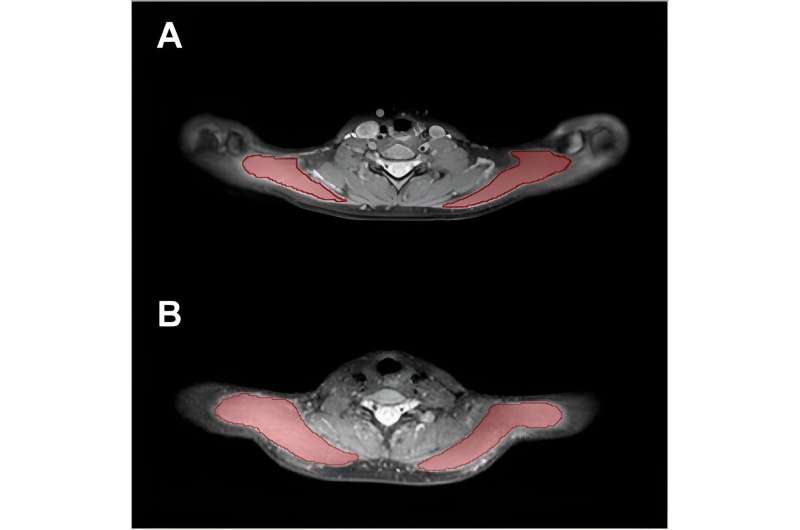This article has been reviewed according to Science X's editorial process and policies. Editors have highlighted the following attributes while ensuring the content's credibility:
fact-checked
trusted source
proofread
Common headaches tied to neck inflammation

Researchers have identified objective evidence of how the neck muscles are involved in primary headaches, according to a study being presented today at the annual meeting of the Radiological Society of North America (RSNA). The findings could lead to better treatments.
The distinct underlying causes of primary headaches are still not fully understood. The most common primary headaches are tension-type headaches and migraines.
"Our imaging approach provides first objective evidence for the very frequent involvement of the neck muscles in primary headaches, such as neck pain in migraine or tension-type headache, using the ability to quantify subtle inflammation within muscles," said Nico Sollmann, M.D., Ph.D., resident in the Department of Diagnostic and Interventional Radiology at University Hospital Ulm, and the Department of Diagnostic and Interventional Neuroradiology at University Hospital Rechts der Isar in Munich, Germany.
Tension-type headaches affect two out of every three adults in the U.S. People with tension-type headaches often feel a tightening in the head and mild to moderate dull pain on both sides of the head. While these headaches are typically associated with stress and muscle tension, their exact origin is not fully understood.
Migraines are characterized by severe throbbing pain. Migraines generally occur on one side of the head, or the pain is worse on one side. Migraines may also cause nausea, weakness and light sensitivity. According to the American Migraine Foundation, over 37 million people in the U.S. are affected by migraine, and up to 148 million people worldwide suffer from chronic migraine.
Neck pain is commonly associated with primary headaches. However, no objective biomarkers exist for myofascial involvement. Myofascial pain is associated with inflammation or irritation of muscle or of the connective tissue, known as fascia, that surrounds the muscle.
For the study, Dr. Sollmann and colleagues aimed to investigate the involvement of the trapezius muscles in primary headache disorders by quantitative magnetic resonance imaging (MRI) and to explore associations between muscle T2 values and headache and neck pain frequency.
The prospective study included 50 participants, mostly women, ranging in age from 20 to 31 years old. Of the study group, 16 had tension-type headache, and 12 had tension-type headache plus migraine episodes. The groups were matched with 22 healthy controls.
All participants underwent 3D turbo spin-echo MRI. The bilateral trapezius muscles were manually segmented, followed by muscle T2 extraction. Associations between muscle T2 values and the presence of neck pain, number of days with headache, and number of myofascial trigger points as determined by manual palpation of the trapezius muscles were analyzed (adjusting for age, sex and body mass index).
The tension-type headache plus migraine group demonstrated the highest muscle T2 values. Muscle T2 was significantly associated with the number of headache days and the presence of neck pain. The increased muscle T2 values could be interpreted as a surrogate of inflammation arising from the nervous system and increased sensitivity of nerve fibers within myofascial tissues.
"The quantified inflammatory changes of neck muscles significantly correlate with the number of days lived with headache and the presence of subjectively perceived neck pain," Dr. Sollmann said. "Those changes allow us to differentiate between healthy individuals and patients suffering from primary headaches."
Muscle T2 mapping could be used to stratify patients with primary headaches and to track potential treatment effects for monitoring.
"Our findings support the role of neck muscles in the pathophysiology of primary headaches," Dr. Sollmann said. "Therefore, treatments that target the neck muscles could lead to a simultaneous relief of neck pain, as well as headache."
Dr. Sollmann pointed out that non-invasive treatment options that directly target the site of pain in the neck muscles could be highly effective and safer than systemic drugs.
"Our imaging approach with delivery of an objective biomarker could facilitate therapy monitoring and patient selection for certain treatments in the near future," he added.
Co-authors are Paul Schandelmaier, M.D., Gabby B. Joseph, Ph.D., Dimitrios C. Karampinos, Ph.D., Meinrad J. Beer, M.D., Claus Zimmer, M.D., Florian Heinen, M.D., Thomas Baum, M.D., and Michaela V. Bonfert. M.D.





















